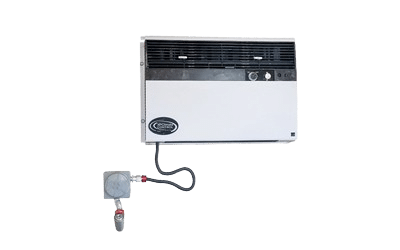Heating
When storing chemicals that require a constant temperature at or above 40°F, our buildings provide unmatched security and safety for workers and materials.
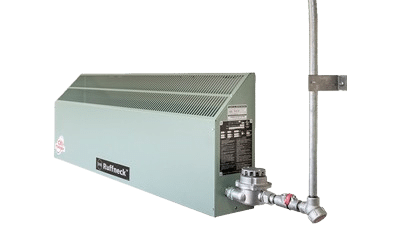
*Heating System
Heating Options for Your Storage Building
When storing chemicals that require a constant temperature at or above 40°F, our buildings provide unmatched security and safety for workers and materials. Depending on your needs, we offer explosion proof and non-explosion proof chemical storage heating systems, including convection and forced air heaters. In addition to temperature-controlled buildings, U.S. Chemical Storage heating options offer a variety of accessories such as R30 insulation or higher, insulated personnel and roll-up doors. Completely customizable construction allows you to have a temperature-controlled hazmat chemical storage building that meets any chemical storage regulation.
Types of Heating
Forced Air Heater
Explosion proof forced air heaters are suited for hazardous locations where specific explosive gases or dusts may be present. These heaters are designed for harsh environments such as:
- Dry indoor industrial applications
- Pulp and paper mills
- Waste water treatment plants
- Oil refineries, petrochemical plants
- Grain elevators, hazardous waste storage facilities
The explosion proof forced air heater offers a larger junction box for easier installation, additional limit controls and a heavy-duty core. The heater core assembly is contained in a sturdy, epoxy coated 14-gauge steel cabinet which also carries the motor and fan assembly. Adjustable louvers allow directional control of the airflow. A narrow gap, two-piece fan guard is provided as a shield. All fasteners are zinc plated for corrosion protection.
Heater units are UL listed and suitable for the following hazardous location classifications:
- Class I, Divisions 1 & 2, Groups C & D
- Class II, Divisions 2, Groups F & G
- Temperature Code T3B 165°C (329°F)
- Class II, Divisions 1, Groups E, F & G
- Class I, Zones 1 & 2, Groups IIA & IIB
Grounding, wiring and breaker size is based on manufacturer recommendations and current NEC. Optional user adjustable thermostat is available, with standard temperature settings from 40⁰ to 85⁰ F. (Higher temperature settings are available with non-standard equipment.)
Non-explosion proof models also available.
Explosion Proof Convection Heaters
Optional one (two, three, etc.) explosion proof convection heaters are suitable for heating hazardous locations. These are ideal for buildings that do not have constant running exhaust fans for up to 70⁰F performance. The design has a sloped top 14-gauge steel cabinet (also available in stainless steel), no exposed copper or brass, high velocity air flow, optional built in thermostat, galvanized steel mounting brackets, and aluminum plate fins.
The heater is suitable for following classifications:
- Groups A, B, C, D; IIA, IIB, IIC ratings
Non-explosion proof models also available.
Features & Benefits
- Weather-resistant steel construction
- Chemical & UV resistant coating
- Can be manufactured to meet EPA, NFPA 30 and NFPA 1
- Continuously welded, leak-tested sump
- Walk-in or rack style available
- 15-year structural warranty
Common Applications
- Hazardous Waste Storage
- Flammable and Combustible Storage
- Paint and solvent Storage
Downloadable Information & Fact Sheets
- Drawing: 2-Hour Bi-Direction Fire Rated Building (FL6115)
- Design Your Explosive Storage Magazine
- Warranty on Building & Accessories
- Buy or Build Chemical Storage Brochure
- Infographic: Choosing a Chemical Storage Building
- FireLoc 1-page Sheet
Compliance & Approvals
At U.S. Chemical Storage we strive to give you the best solution for your operations. This building and its accompanying accessories can be engineered to meet the following approvals and certifications based upon your unique set of needs.
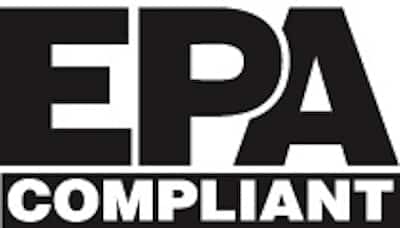
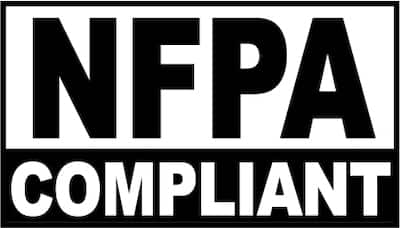


Frequently Asked Questions
First consult the Safety Data Sheet (SDS) to determine the type of chemical you’re storing and any storage requirements listed. There are two main classifications of buildings to consider: fire-rated and non-fire-rated steel buildings.
There are three main questions you should answer before engineering or design can begin on your building: what is to be stored, how much of it is being stored, and where is the location it will be stored? You will also need to consult with your local “Authority Having Jurisdiction” (AHJ) or local code expert to determine your area’s specific storage building requirements.
Our team at U.S. Chemical Storage has a wealth of knowledge, experience, and resources to help analyze your storage needs, but the final approval is made by the local AHJ, so you will need to ultimately ask them about your requirements early in the planning process.
The definition of a “sump” is a pit or reservoir providing containment for spilled liquids. U.S. Chemical Storage offers leak-proof spill containment sumps in each standard model. All our sumps are tested for leaks for a 24-hour period prior to finishing. The sump is then covered by a steel or fiberglass floor grating and can even be equipped with a resistant plastic sump liner to protect against corrosive chemical accidental spills. The size of the sump is dictated by code based on the volume of liquid being stored within the building.
Building size is determined by the amount of hazardous material you are planning to store, the need for occupancy or inspection around these materials, and must take into consideration the most efficient way of moving these materials into and out of your chemical storage building.
Location of the building can be either inside another building or outside to fit your needs. Fire Separation, which is the amount of fire rating required between two occupancies, or the separation distance between those two occupancies, is determined by the type of chemical or hazard being stored, and distances between buildings, egress pathways, or environmental features. To determine the required fire separation, it is best to consult with your local code authority. Inside another building or within 10 feet of another building, you’ll be required to have a 4-hour fire rating. If your hazmat storage building is located at distances 30 feet or greater your building may not be required to have a fire rating at all.
Request a Quote
Other Types of Climate Control Accessories
Cooling Options for Your Storage Building
Our air-conditioned chemical storage buildings allow for optimum temperature control while storing your hazardous materials safely.
Exhaust Fan Options for Your Storage Building
There are many exhaust fan options available to complete your U.S. Chemical Storage building customization.
RELATED ARTICLES
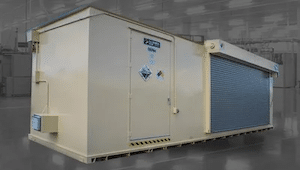
How To Store Lithium Batteries
Lithium batteries are often used in today’s electronic environments.
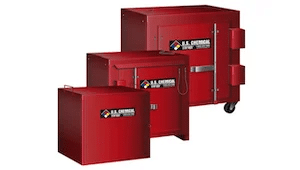
Explosive Storage Magazines
Prevent accidents by storing your high and low explosives properly.

Pharma Hazmat Storage
This manufacturing process needed a compliant 90 day storage solution.


